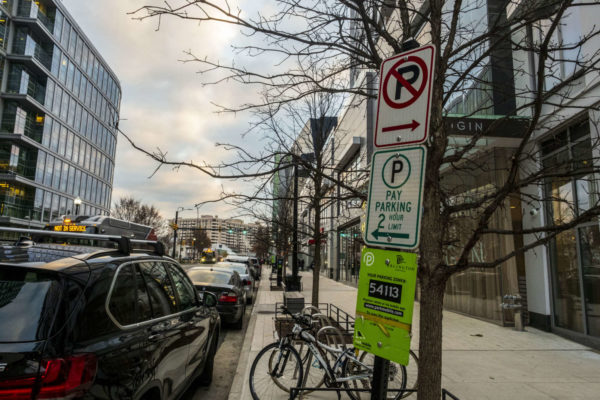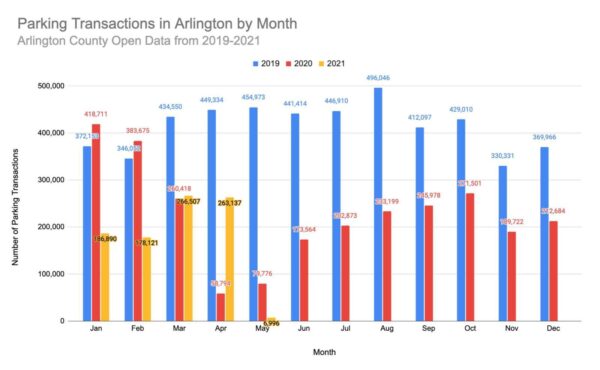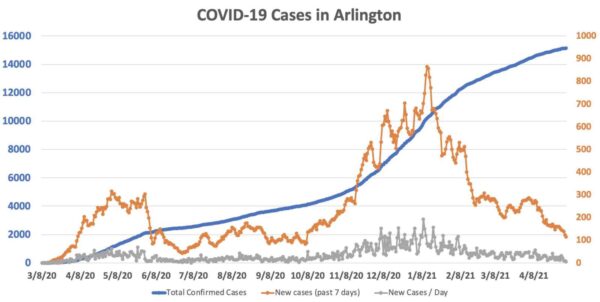With COVID-19 cases declining and 31% of the local population fully vaccinated, more people appear to be out and about in Arlington, according to recent county parking data.
Arlington County logged more than 266,500 and 263,000 parking meter transactions in March and April, respectively — the highest these numbers have been since October when cases started mounting for the second time in 2020.
The figures are one indication that Arlington has returned to a level of activity last seen in Arlington late last summer when case numbers were low and the state lifted many of the restrictions on daily life.
While parking numbers have recovered from the second and larger wave of coronavirus, the road to pre-pandemic parking levels may still be a long one. The transactions this spring are roughly 40% lower than they were in the spring of 2019.
The parking transaction trends appear to be the inverse of COVID-19 cases in Arlington.
Parking transactions dropped dramatically between October to November, during which time coronavirus cases started rising. Parking transactions bounced back in March and remained at similar levels in April; meanwhile, COVID-19 cases have reached their lowest point since October.
Today, the Virginia Dept. of Health reported only five new cases in Arlington, after nine new cases were reported yesterday — the first two-day stretch of single-digit new cases in the county since Sept. 1-2.
Arlington’s recently-adopted budget projects parking revenue getting close to pre-pandemic levels by the end of the 2022 fiscal year, “but there is a lot of uncertainty about that assumption,” parking manager Stephen Crim said.
The county has a long way to go to recover lost parking revenue, which plummeted from a 2019 peak of nearly 500,000 transactions in August to fewer than 60,000 transactions in April 2020.
If the revenue trends from April continue into May and June, however, parking revenue for the second quarter of 2021 could surpass the $1.4 million that the county logged through March, county officials say.
“A return to pre-pandemic levels will depend not only on how quickly jurisdictions lift restrictions on places like restaurants but also on how comfortable people feel going back to their usual activities,” Crim said. “Also, there may be medium- or long-term changes to the way people shop, socialize and conduct business meetings, which could affect parking in Arlington, just like everywhere else.”
In February, Gov. Ralph Northam rolled back a 10 p.m. alcohol curfew for restaurants to midnight, and by mid-May, he is expected to raise the caps on venue capacity and social gatherings, while lifting the curfew on liquor sales. Last month, the Centers for Disease Control and Prevention cleared Americans to be outside without a mask in most situations. Soon after, Virginia followed suit.
Although transactions levels are lower, the overall patterns of where people park are generally similar to pre-pandemic patterns, Crim said.
“A quick look at some of our meter data indicates that areas that were popular pre-pandemic remain popular today and areas that were less popular are still less popular,” he said.
He did not indicate whether the county expects a new pilot program that prices parking by demand along Metro corridors — approved by the County Board in December — will impact parking transaction rates.
Arlington’s Department of Environmental Services will be conducting the performance parking pilot to improve parking management, “regardless of the overall number of people who want to park in Arlington,” Crim said.
“We started planning for this pilot well before the pandemic struck and we don’t see the pilot as an opportunity to shore up revenue,” he said.
Charts compiled by ARLnow using data from Arlington County and Virginia Department of Health




